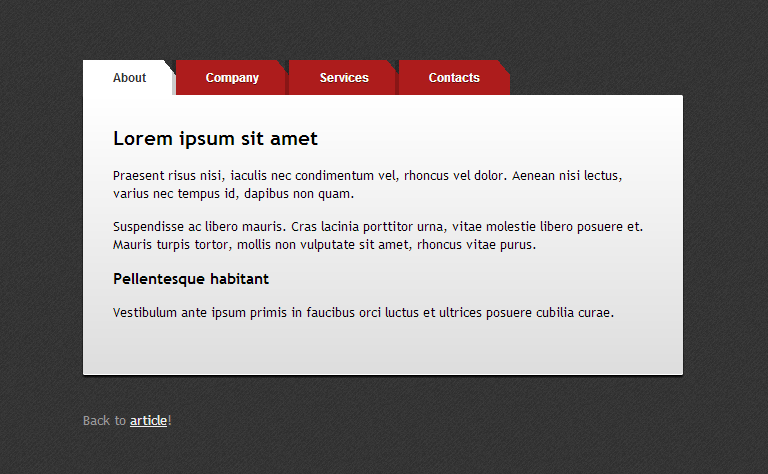To organize content on site was always an important task for web designers. Using a CSS3 tabbed navigation can help you structuring similar groups of content.
Along with so many rounded corners (which lately became the default), today you’ll learn how to create some good looking CSS3 tabs with beveled corners. We’ll do that using a clever CSS3 gradients technique.

The HTML
The purpose here, as usual, is to write clean and semantic markup: unordered list for the tabbed navigation and simple
div
‘s for wrapping content.
So, check the HTML below:
The CSS
Minimal and easy to update styles, also no images were used here:
#tabs
{
overflow: auto;
width: 100%;
list-style: none;
margin: 0;
padding: 0;
}
#tabs li
{
margin: 0;
padding: 0;
float: left;
}
#tabs a
{
-moz-box-shadow: -4px 0 0 rgba(0, 0, 0, .2);
-webkit-box-shadow: -4px 0 0 rgba(0, 0, 0, .2);
box-shadow: -4px 0 0 rgba(0, 0, 0, .2);
background: #ad1c1c;
background: -moz-linear-gradient(220deg, transparent 10px, #ad1c1c 10px);
background: -webkit-linear-gradient(220deg, transparent 10px, #ad1c1c 10px);
background: -ms-linear-gradient(220deg, transparent 10px, #ad1c1c 10px);
background: -o-linear-gradient(220deg, transparent 10px, #ad1c1c 10px);
background: linear-gradient(220deg, transparent 10px, #ad1c1c 10px);
text-shadow: 0 1px 0 rgba(0,0,0,.5);
color: #fff;
float: left;
font: bold 12px/35px 'Lucida sans', Arial, Helvetica;
height: 35px;
padding: 0 30px;
text-decoration: none;
}
#tabs a:hover
{
background: #c93434;
background: -moz-linear-gradient(220deg, transparent 10px, #c93434 10px);
background: -webkit-linear-gradient(220deg, transparent 10px, #c93434 10px);
background: -ms-linear-gradient(220deg, transparent 10px, #c93434 10px);
background: -o-linear-gradient(220deg, transparent 10px, #c93434 10px);
background: linear-gradient(220deg, transparent 10px, #c93434 10px);
}
#tabs a:focus
{
outline: 0;
}
#tabs #current a
{
background: #fff;
background: -moz-linear-gradient(220deg, transparent 10px, #fff 10px);
background: -webkit-linear-gradient(220deg, transparent 10px, #fff 10px);
background: -ms-linear-gradient(220deg, transparent 10px, #fff 10px);
background: -o-linear-gradient(220deg, transparent 10px, #fff 10px);
background: linear-gradient(220deg, transparent 10px, #fff 10px);
text-shadow: none;
color: #333;
}
#content
{
background-color: #fff;
background-image: -webkit-gradient(linear, left top, left bottom, from(#fff), to(#ddd));
background-image: -webkit-linear-gradient(top, #fff, #ddd);
background-image: -moz-linear-gradient(top, #fff, #ddd);
background-image: -ms-linear-gradient(top, #fff, #ddd);
background-image: -o-linear-gradient(top, #fff, #ddd);
background-image: linear-gradient(top, #fff, #ddd);
-moz-border-radius: 0 2px 2px 2px;
-webkit-border-radius: 0 2px 2px 2px;
border-radius: 0 2px 2px 2px;
-moz-box-shadow: 0 2px 2px #000, 0 -1px 0 #fff inset;
-webkit-box-shadow: 0 2px 2px #000, 0 -1px 0 #fff inset;
box-shadow: 0 2px 2px #000, 0 -1px 0 #fff inset;
padding: 30px;
}
/* Remove the rule below if you want the content to be "organic" */
#content div
{
height: 220px;
}
The jQuery
The code below it may not be the best possible, but I think it’s pretty decent 🙂
$(document).ready(function() {
$("#content div").hide(); // Initially hide all content
$("#tabs li:first").attr("id","current"); // Activate first tab
$("#content div:first").fadeIn(); // Show first tab content
$('#tabs a').click(function(e) {
e.preventDefault();
$("#content div").hide(); //Hide all content
$("#tabs li").attr("id",""); //Reset id's
$(this).parent().attr("id","current"); // Activate this
$('#' + $(this).attr('title')).fadeIn(); // Show content for current tab
});
})();
The result
Check out the transparent corners! You can use the tabs with any background image. No side effects, no overlapping colors to match or something else.
Also, the left shadow helps creating the effect of overlapping tabs.
Browser support
This demo is working also for older browsers. It just look slightly different, as no CSS3 support is available.